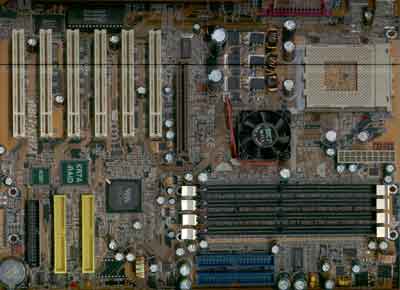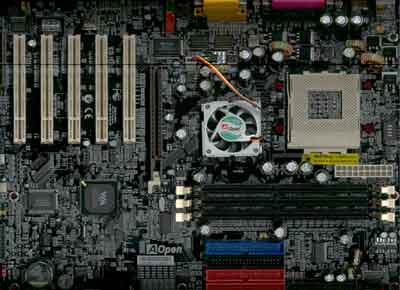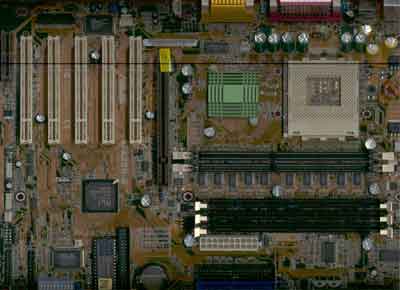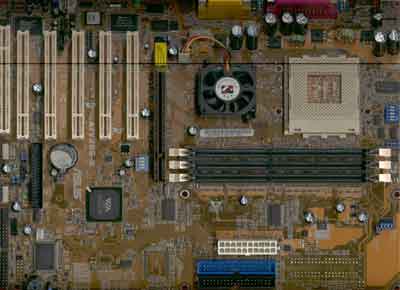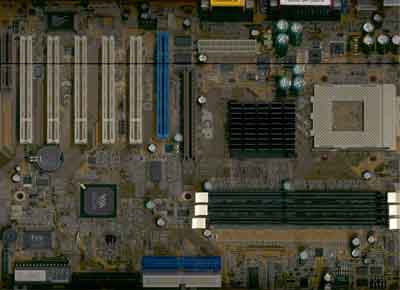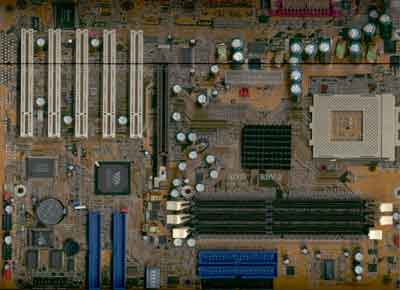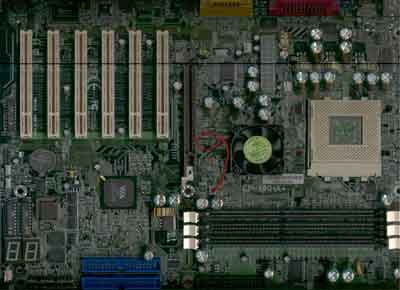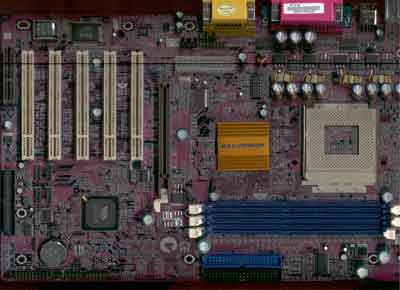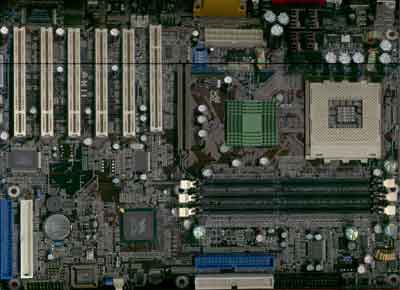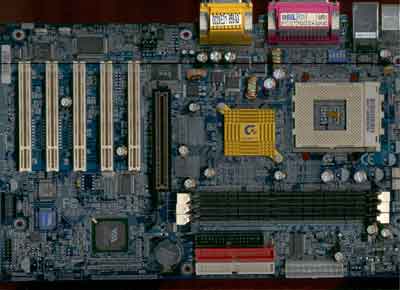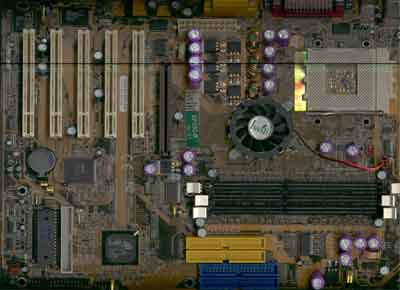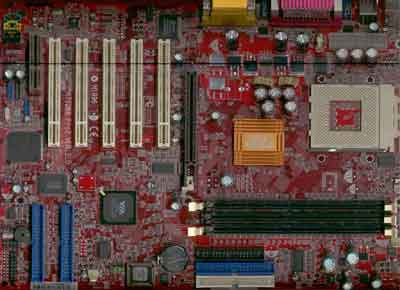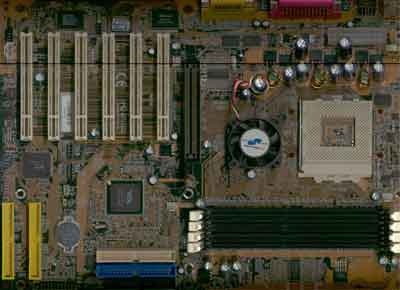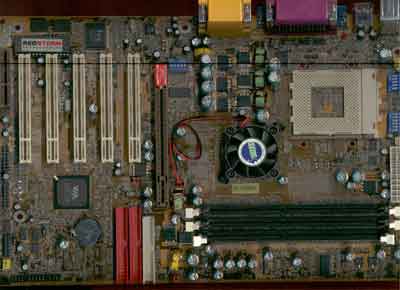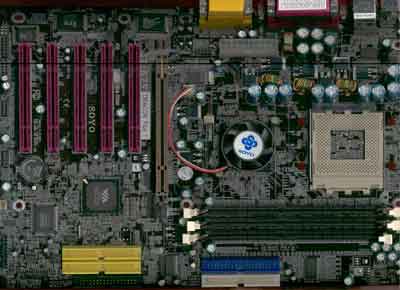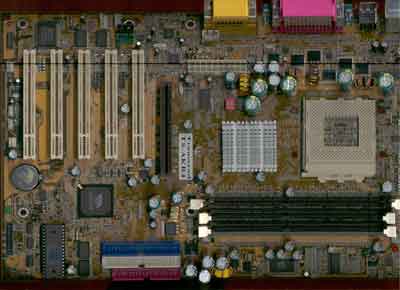
Original Link: https://www.anandtech.com/show/870
VIA KT266A Motherboard Roundup - January 2002
by Mike Andrawes on January 18, 2002 4:48 AM EST- Posted in
- Motherboards
AMD plays the PC game much differently than Intel. Intel will not only develop CPUs but also the platforms they run on and not to mention all of the other technologies that are now further enabled by the processors. A very good example would be the launch of the Pentium 4; Intel has done their best to outfit all market segments with Pentium 4 chipsets from the i850 and i845 with DDR SDRAM to the i845 with PC133 SDRAM and the upcoming i845G.
AMD remains very focused on CPUs and only rises to the role of a chipset manufacturer when it's absolutely necessary. Case in point would be the release of the AMD 760 chipset which enabled DDR SDRAM to be used on Athlon platforms, and more recently the AMD 760MP/MPX platforms that finally brought dual processor support.
AMD has relied in third party manufacturers to supply chipsets for their CPUs for the longest time. Back in the Socket-7 days it was Intel that provided the majority of the chipsets, and eventually VIA took over the role. The Athlon itself would have never succeeded had it not been for VIA's support but as any business mind will tell you, it's dangerous to put all your eggs in one basket. AMD began encouraging other chipset manufacturers such as ALi, SiS and eventually even NVIDIA to develop Athlon platforms.
Around the Computex 2001 timeframe VIA was feeling quite a bit of pressure as it seemed like motherboard vendors were tempted by SiS' 735 and the then forthcoming nForce. Fast-forwarding to the present day, many of VIA's fears were unwarranted.
While the SiS 735 exhibited excellent performance combined with a very low cost, motherboard manufacturers were not quick to adopt the solution. Other than ECS' extremely low-priced K75SA, there were no more than a handful of boards made based on the 735 chipset.
Even more of a disappointment was the launch of NVIDIA's nForce. We still firmly believe in the capabilities of the chipset but what was originally the highlight of Computex fizzled at its official shipping launch in late 2001. There is still much potential for the chipset with more affordable solutions coming this year but it seems like we were all a little too optimistic about how revolutionary NVIDIA's first shot at a PC chipset would be. The nForce platform will be an interesting one to keep an eye on, but it's not destined to replace VIA's role in the Athlon's growth anytime soon.
This leaves us with by far the most desirable Athlon platform on the market - VIA's KT266A. While most manufacturers won't touch their Pentium 4 chipsets with a 10 foot pole, there isn't a single motherboard manufacturer in Taiwan that isn't happy to feature the KT266A chipset. Much of the success of the AMD Athlon XP's launch can be attributed to this chipset which performs so very well and allows the processor to truly spread its wings. With a chipset this important, how could we not make a roundup out of it?
In this roundup, besides KT266A boards, we also threw in two boards using the latest stepping of ALi's MAGiK 1 chipset - the ASUS A7A266-E and the Iwill XP333. On the KT266A side, we have a total of 14 candidates; they are the ABIT KR7A-RAID, AOpen AK77 Plus, ASUS A7V266-E, Chaintech CT-7VJDA, DFI AD70-SR, ECS K7VTA3, EPoX 8KHA+, FIC AN11, Gigabyte 7VTXH, MSI K7T266 Pro2, Shuttle AK35GTR, Soltek SL-75DRV2, Soyo AY-K7V Dragon Plus! and the Transcend TS-AKR4.
KT266A vs. ALi MAGiK 1
The VIA KT266A chipset is VIA's latest solution for AMD processors. It delivers the best performance for AMD users out there at a relatively affordable price. Some of the boards in this roundup can be found for around 100 dollars. KT266A motherboards are also widely available, so you should have no problem finding a variety of them in the local computer stores or especially online.
The chipset is made up of the VIA VT8366A North Bridge and the VT8233 South Bridge connected using VIA's V-Link bus. Regardless of which OS you're running (9x, Me, 2000, XP), in order to setup a KT266A motherboard you simply have to install the most recent VIA 4-in-1 driver, which at the time of publication was v4.37.
Although it was released before the KT266A, the ALi MAGiK 1 definitely lacks the popularity of the KT266A. The performance of the solution isn't as high as the KT266A but to make up for it the price of these boards are usually lower than their VIA counterparts.
The chipset is made up of the ALi M1647 North Bridge and the M1535D+ South Bridge. Much like setting up a VIA based system, downloading the latest drivers from ALi's website is all that is necessary to be on your way.
Lab Notes
Over time we have seen tremendous improvements in motherboard development. Comparing the stability and compatibility issues of motherboards from just 5 years ago to those of today makes you truly realize how much this industry has matured in recent history; and we see that trend continue today in this roundup.
The most important aspect of any product you put in your PC is stability. We're glad to say that all the boards reviewed here were very stable in our stress tests, even with all the memory slots populated. In the past we noticed that motherboards from big manufacturers like ASUS and Gigabyte were generally the only stable solutions while boards from smaller names suffered; we are starting to see that trend disappear. This has a lot to do with the solid engineering job manufacturers put into designing the board and also the increased quality of components used. Manufacturers are a lot more selective of the parts they will use today and their equipment has improved as well.
We also noticed that features have now become a very important part of different motherboards. In the past, as long as a motherboard had memory slots and worked it was considered to be part of the norm. Today, manufacturers try to integrate as many features as possible such as RAID controllers, on-board audio and LAN, debugging devices, as well as overclocking features. Out of the boards we tested in this roundup, almost half of them contain some sort on on-board RAID controllers and all but two boards feature on-board audio (some of them even have 6 channel audio solutions).
Almost all boards in this roundup are rich in overclocking features as well. In the past, only a handful of boards would feature adjustable FSB speeds in 1MHz increments. In this roundup, all but two boards have that feature. Moreover, all the boards offer a decent range of selectable CPU core voltages and some of them even provide I/O or even DDR voltage manipulation for more flexible overclocking.
The icing on the proverbial cake comes in the manuals. While some boards still came with a thin booklet containing a little bit of information on jumpers and connectors, a lot of the boards actually came with very detailed manuals with all the details about the board. It's not a big deal but it's nice to see that all parts of the package are improving.
ABIT KR7A-RAID
|
ABIT KR7A-RAID |
|
|
CPU
Interface
|
Socket-A
|
|
Chipset
|
VT8366A
North Bridge
VT8233 South Bridge |
|
Form
Factor
|
ATX
|
|
Bus
Speeds
|
100
- 200MHz (in 1MHz increments)
|
|
Core
Voltages Supported
|
1.100
- 1.850V (in 0.025V increments)
|
|
I/O
Voltages Supported
|
3.5/3.65V
|
|
DRAM
Voltages Supported
|
2.55
/ 2.65 / 2.75 / 2.85 V
|
|
Memory
Slots
|
4
184-pin DDR DIMM Slots
|
|
Expansion
Slots
|
1
AGP Slot
6 PCI Slots |
|
Onboard
RAID
|
HighPoint
HPT372 (RAID 0, 1, 0+1,span)
|
|
Onboard
USB 2.0/IEEE-1394
|
N/A
|
|
Onboard
Audio
|
N/A
|
It took ABIT a lot of time and hard work to gain their reputation among hardware enthusiasts, there is no way they would give it up without a fight. With increasing pressure from other manufacturers to produce more stable boards with more overclocking features, ABIT still managed to come up with a design that is still eye catching.
The moment you see the KR7A-RAID you will notice its 6 PCI slots and 4 DIMM slots; the most useful of the two being the 4 DIMM slots. As we have stated numerous times before, it's quite an engineering accomplishment to be able to have 4 DIMM slots on a DDR board like the KR7A-RAID. The board worked just fine with all slots populated.
As the name indicates, the KR7A-RAID features a HighPoint RAID controller. The only difference between the controller used on this board and what ABIT has previously used is its support for ATA-133. However even with multi-drive RAID arrays you will find it difficult to be limited by the ATA-100 spec. We've already covered the issues with this RAID controller in our i845 motherboard roundup.
On the overclocking side, the KR7A-RAID uses ABIT's trademark SoftMenu III setup. ABIT is the only manufacturer in this roundup to offer voltage adjustments for the CPU core, I/O, and memory. However, the memory voltage adjustment option only has 4 settings with a 2.85V maximum, whereas their AMD 760 board (KG7-RAID) provided more values.
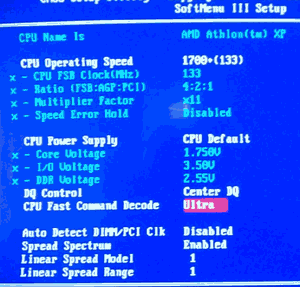
There is a heatsink and fan on the KT266A's North Bridge, which is also the case for almost all the other KT266A motherboards. Besides the two integrated USB ports at the back of the board among the I/O panels, ABIT also included the headers for the second and third USB ports on the left side of the board. All you need is plug in the extra USB ports and you are ready to go.
We had high expectations of the KR7A-RAID and after our testing we had even more positive things to say. The KR7A-RAID combines features, flexibility and stability in a package that we can easily recommend to anyone looking for a KT266A based motherboard.
AOpen AK77 Plus
|
AOpen AK77 Plus |
|
|
CPU
Interface
|
Socket-A
|
|
Chipset
|
VT8366A
North Bridge
VT8233 South Bridge |
|
Form
Factor
|
ATX
|
|
Bus
Speeds
|
100
- 248MHz (in 1MHz increments)
|
|
Core
Voltages Supported
|
1.100
- 1.850V (in 0.025V increments)
|
|
I/O
Voltages Supported
|
Not
Configurable
|
|
DRAM
Voltages Supported
|
Not
Configurable
|
|
Memory
Slots
|
3
184-pin DDR DIMM Slots
|
|
Expansion
Slots
|
1
AGP Slot
6 PCI Slots 1 CNR Slot |
|
Onboard
RAID
|
N/A
|
|
Onboard
USB 2.0/IEEE-1394
|
N/A
|
|
Onboard
Audio
|
Analog
Devices AD1885 AC'97 Codec
|
From the outside, it seems that AOpen's AK77 Plus would be a pretty decent competitor but there's always room for improvement.
The board comes in with 3 DIMM slots all of which can be populated without sacrificing stability. The AK77 Plus features on-board RAID courtesy of a Promise PDC20265R IDE RAID controller, for more information on this controller you can read about it in our i845 DDR Motherboard Roundup.
Our major complaints stem from poor overclocking options. In order to change FSB frequencies between 100MHz and 133MHz you must use a jumper and there is also no multiplier control from within the BIOS. There's no reason for AOpen not to offer these options within the BIOS as most competing manufacturers have been doing so for quite some time.
Another interesting fact we noticed was that the board was only providing our
test Athlon XP CPU with 1.70V instead of the 1.75V default it was set to. This
could result in instability, especially under stressful conditions.
In order to improve the design we'd suggest that AOpen consider implementing
100/133MHz FSB and multiplier control as options that can be easily adjusted
from within the BIOS.
ASUS A7A266-E
|
ASUS A7A266-E |
|
|
CPU
Interface
|
Socket-A
|
|
Chipset
|
ALi
M1647 North Bridge
ALi M1535D+ South Bridge |
|
Form
Factor
|
ATX
|
|
Bus
Speeds
|
100
- 166MHz (in 1MHz increments)
|
|
Core
Voltages Supported
|
1.125
- 1.850V (in 0.025V increments)
|
|
I/O
Voltages Supported
|
Not
Configurable
|
|
DRAM
Voltages Supported
|
2.5 / 2.6 V
|
|
Memory
Slots
|
2
184-pin DDR DIMM Slots
3 168-pin SDR DIMM Slots |
|
Expansion
Slots
|
1
AGP Pro Slot
5 PCI Slots 1 AMR Slot |
|
Onboard
RAID
|
N/A
|
|
Onboard
USB 2.0/IEEE-1394
|
N/A
|
|
Onboard
Audio
|
C-Media
CMI 8738
|
A lot of people were very disappointed about the first version of the ALI MaGiK 1 chipset because of its sub-par performance, and a lot of manufacturers hesitated in putting the chipset on their motherboards. After more revisions of the chipset, the latest version from ALi finally caught up with the KT266A.
ASUS was one of the few manufacturers who did release a board using the original ALi MaGiK 1 chipset with the A7A266. This time around, ASUS released a new revision of the board using the C-stepping of the chipset - calling it the A7A266-E.
In an attempt to capture more marketshare ASUS put in 2 DDR DIMM slots and 3 SDR DIMM slots so you can have more flexibility in memory choice. However, with a maximum of 3GB / 6 rows of memory access, ASUS should have put in 3 DDR DIMM slots, especially when 512MB modules still aren't common yet.
ASUS continues to use their special Medallion 6.00 BIOS for the A7A266-E. It offers reasonable amount of overclocking setups including voltage tweakings for CPU core and memory, but overclocking wasn't as impressive on the board as some other candidates we have seen in this roundup.
The main reason behind this is the lack of 1/6 divider for the PCI bus. In the BIOS, as you increase the FSB speed you can also see the corresponding speed the PCI bus will be running. At 166MHz you can see that the PCI bus is running at 42MHz, which corresponds to a 1/4 divider. Ideally, with a 1/5 divider, the PCI bus will continue to run at 33MHz to maintain system stability.
Moreover, the system does not allow you to run your FSB and memory asynchronously, meaning that you will be pushing your memory as you increase the FSB speed.
On the other hand, the board follows ASUS's tradition and was rock solid throughout all of our tests. The two extra USB connectors give you the options to connect more devices to the system, though ASUS doesn't ship the board with additional USB ports.
The A7A266-E came out a bit later than their KT266A solution, the A7V266-E, and it's clear that the board is not as feature rich as the A7V266-E.
ASUS A7V266-E
|
ASUS A7V266-E |
|
|
CPU
Interface
|
Socket-A
|
|
Chipset
|
VT8366A
North Bridge
VT8233 South Bridge |
|
Form
Factor
|
ATX
|
|
Bus
Speeds
|
100
- 227MHz (in 1MHz increments)
|
|
Core
Voltages Supported
|
1.700
- 1.850V (in 0.025V increments)
|
|
I/O
Voltages Supported
|
Not
Configurable
|
|
DRAM
Voltages Supported
|
2.5 / 2.6 / 2.7 / 2.8 V
|
|
Memory
Slots
|
3
184-pin DDR DIMM Slots
|
|
Expansion
Slots
|
1
AGP Pro Slot
5 PCI Slots 1 ACR Slot |
|
Onboard
RAID
|
Promise
PDC20265
|
|
Onboard
USB 2.0/IEEE-1394
|
N/A
|
|
Onboard
Audio
|
C-Media
CMI 8738
|
Compared to the A7A266-E, the A7V266-E is a much better DDR solution from ASUS. However, it doesn't seem to be as unique when compared to its esteemed competitors in this roundup.
The board offers a very wide range of FSB speed settings, and you can monitor the PCI bus speed you will be running as well. However, just like the A7A266-E, the A7V266-E only provides a 1/4 divider for the PCI bus.
It's been a classic ASUS trait to provide more voltage to the CPU thus improving stability a bit. In our tests we noticed that even at default settings, the CPU was running at almost 1.80V instead of 1.75V, a 2.8% differential. This gap continues when we continued to increase the CPU voltage, which means you are always running a higher voltage than what you expected.
Although it wasn't available on our evaluation sample, the A7V266-E also has an optional RAID controller. ASUS continues to use the Promise PDC20265 controller, which supports ATA100 RAID. The board also features the C-Media CMI8738 PCI 6 channel-LX sound chip. Although the board doesn't overclock as nicely as we expected, it was again very stable during our tests which has become ASUS' trademark.
In short, the A7V266-E is a very solid KT266A solution from ASUS, although it falls behind in terms of board features. ASUS has definitely lost the overclocking game with their KT266A board, but hopefully their next solution will restore some of that competitive spirit to the motherboard titan.
Chaintech CT-7VJDA
|
Chaintech CT-7VJDA |
|
|
CPU
Interface
|
Socket-A
|
|
Chipset
|
VT8366A
North Bridge
VT8233 South Bridge |
|
Form
Factor
|
ATX
|
|
Bus
Speeds
|
100
- 166MHz (in 1MHz increments)
|
|
Core
Voltages Supported
|
+0.025
- +0.350 V (in 0.025V increments)
|
|
I/O
Voltages Supported
|
Not
Configurable
|
|
DRAM
Voltages Supported
|
Not
Configurable
|
|
Memory
Slots
|
3
184-pin DDR DIMM Slots
|
|
Expansion
Slots
|
1
AGP Slot
5 PCI Slots 1 ACR Slot 1 CNR Slot |
|
Onboard
RAID
|
N/A
|
|
Onboard
USB 2.0/IEEE-1394
|
N/A
|
|
Onboard
Audio
|
C-Media
CMI 8738
|
Just like their AMD 760 solution, the Chaintech CT-7VJDA comes with a large size heatsink on the North Bridge, rather than a much smaller HSF unit. While we are not sure about the reason behind this, one possibility is to cut down the cost of manufacturing the board. You can easily find the board selling for less than 90 dollars in the market, which is very attractive.
The board has a total of 3 DIMM slots, something very common among all KT266A boards. While the CT-7VJDA doesn't offer any voltage tweakings for I/O or memory, the CPU core voltage could be increased by as much as 0.350V, which could be substantially higher than the default voltage. This could be good news for hardcore overclocking, but at the same time extensively cooling has to be done to avoid damaging the CPU.
There is a jumper on the board separating the 100/133MHz FSB range, which makes overclocking a bit of trouble when going over the boundary. Same thing goes for the chip multiplier ratio setup, which is done through a set of 4 dipswitches instead of inside the BIOS.
The CT-7VJDA also uses the C-Media CMI8737 PCI sound chip for better audio capabilities. The ACR and CNR slots on the board make it a good candidate for the OEM market but it's definitely not as useful for end users like us. We would rather see the ACR slot replaced by another PCI slot.
The board was mostly stable throughout our tests although we did encounter some small lockups during the Content Creation Winstone 2002. The CT-7VJDA might not be the best board for overclocking out there, but it could still be a very good candidate for Duron users.
DFI AD70-SR
|
DFI AD70-SR |
|
|
CPU
Interface
|
Socket-A
|
|
Chipset
|
VT8366A
North Bridge
VT8233 South Bridge |
|
Form
Factor
|
ATX
|
|
Bus
Speeds
|
100
- 250MHz (in 1MHz increments)
|
|
Core
Voltages Supported
|
1.500
- 1.850V (in 0.025V increments)
|
|
I/O
Voltages Supported
|
Not
Configurable
|
|
DRAM
Voltages Supported
|
Not
Configurable
|
|
Memory
Slots
|
3
184-pin DDR DIMM Slots
|
|
Expansion
Slots
|
1
AGP Slot
5 PCI Slots |
|
Onboard
RAID
|
Promise
PDC 20265
|
|
Onboard
USB 2.0/IEEE-1394
|
N/A
|
|
Onboard
Audio
|
N/A
|
Recently DFI has started to pick up the pace in the enthusiasts market, and we continue to see this trend in the AD70-SR. The AD70-SR recently got its name changed to distinguish itself from its older KT266 brother, the AD70.
The AD70-SR has a very wide range of FSB speeds from 100MHz to 250MHz. Although the 100/133MHz jumper is still present on the board, the wide range of speeds available is already a big jump for DFI. There are no voltage settings for I/O and memory on the AD70-SR, while a decent range of settings are available for CPU core.
One important feature DFI implemented on the board was the asynchronous memory setting, allowing you to run your memory slower than the FSB speed as you continue to increase the FSB. Although the board couldn't hit very high FSB values without compensating the stability, this is a nice option provided by DFI.
The board also comes in with the Promise PDC 20265 RAID controller supporting ATA100. In order to reduce the cost DFI decided not to put an integrated sound chip on the AD70-SR, and the result is a 100-dollar board that is very stable with RAID functions.
EPoX EP-8KHA+
|
EPoX EP-8KHA+ |
|
|
CPU
Interface
|
Socket-A
|
|
Chipset
|
VT8366A
North Bridge
VT8233 South Bridge |
|
Form
Factor
|
ATX
|
|
Bus
Speeds
|
100
- 210MHz (in 1MHz increments)
|
|
Core
Voltages Supported
|
-0.100
/ -0.075 / -0.050 / -0.025 /
+0.025 / +0.050 / +0.075 / +0.100 |
|
I/O
Voltages Supported
|
+0.1
/ +0.2 / +0.3 / +0.4 / +0.5 / +0.6 / +0.7
|
|
DRAM
Voltages Supported
|
Not
Configurable
|
|
Memory
Slots
|
3
184-pin DDR DIMM Slots
|
|
Expansion
Slots
|
1
AGP Slot
6 PCI Slots |
|
Onboard
RAID
|
N/A
|
|
Onboard
USB 2.0/IEEE-1394
|
N/A
|
|
Onboard
Audio
|
Avance
Logic ALC201A AC97 CODEC
|
EPoX came out with the 8KHA+ with only one competitor in mind - ABIT. Before the release of the ABIT KR7-RAID, the EPoX was one of the best KT266A boards out there, providing possibly the best overclocking ability and also stability.
Shortly after the KR7-RAID hit the market, EPoX started to leak out a beta BIOS, which is the one that we used for our roundup. The BIOS is not officially under the EPoX web page but you can easily find it floating on the Internet.
The BIOS, with release date 11/30/2001, provides the ability for you to practically push the FSB of the board to over 200MHz, which has been confirmed by a lot of sources. This is made possible by two very important features by EPoX, the 1/5 and 1/6 PCI bus divider and also the 100/133 memory bus divider. With these two settings, you can be running your FSB at 200MHz while maintaining the memory and PCI buses at 150MHz and 33MHz respectively. The memory could be compensated by the new PC2400 or PC2700 parts, and the PCI bus is still within spec.
However, we could only achieve as high as 185MHz in our test labs before the system lost its stability. Although it was still far from the 200MHz mark, it's already one of the highest FSB speeds achieved, and it's also a good indication that 200MHz FSB systems are not that far away.
Unfortunately, high speed overclocking could also come in a big price. During our overclocking test we actually corrupted one of our Western Digital hard drive at around 190MHz, resulting in a loss of all the data on the hard drive. This could be disastrous if you contain valuable information on your hard drive. Therefore, make sure you perform overclocking with caution at all times.
There are plenty of voltage settings available for both the CPU core and the DDR memory, which makes overclocking even more interesting. But just like the ASUS A7V266-E, we also noticed that the EP-8KHA+ is running the CPU at 0.05V over all the time, so you have to careful on the CPU cooling as well. The board also has the hexadecimal indicator showing the status of the system during boot-up, so you can find out what's wrong with the system if it doesn't boot up correctly.
The board also has 6 PCI slots, where ABIT is the only other company that achieved this design. 2 sets of extra USB connectors are available for 4 more USB devices, and EPoX includes header for one set of connector.
During our initial roundup, the board suffered severe compatibility issues with the NVIDIA GeForce3 Ti500 video cards, but the problem has been solved with the recent BIOS update. We now have no problem installing Windows 2000 using the Ti500.
However, our biggest complain against the EP-8KHA+ is the lack of 4 DDR DIMM slots and onboard IDE RAID controller. With these two features EPoX would be able to raise themselves even higher. Fortunately, EPoX seems to listen to all the enthusiasts out there, and they will be releasing an updated version of the EP-8KHA+ soon. The new board, named EP-8KHA2, will have 4 DIMM slots and the new Highpoint HPT372 IDE RAID controller. If the board can maintain high stability with all 4 DIMMs populated, it would be in a really close game with the ABIT KR7-RAID.
ECS K7VTA3
|
ECS K7VTA3 |
|
|
CPU
Interface
|
Socket-A
|
|
Chipset
|
VT8366A
North Bridge
VT8233 South Bridge |
|
Form
Factor
|
ATX
|
|
Bus
Speeds
|
100
/ 120 / 133 / 140 / 150 MHz
|
|
Core
Voltages Supported
|
Not
Configurable
|
|
I/O
Voltages Supported
|
Not
Configurable
|
|
DRAM
Voltages Supported
|
Not
Configurable
|
|
Memory
Slots
|
3
184-pin DDR DIMM Slots
|
|
Expansion
Slots
|
1
AGP Slot
5 PCI Slots 1 CNR Slot |
|
Onboard
RAID
|
N/A
|
|
Onboard
USB 2.0/IEEE-1394
|
N/A
|
|
Onboard
Audio
|
Avance
Logic ALC100P AC 97 CODEC
|
By no means is the ECS K7VTA3 for any of the hardware enthusiasts out there. This board lacks almost every single overclocking option, including the multiplier ratio setting. This effectively limits the amount of speed you can squeeze out.
There are no voltage options at all, and only 5 FSB settings between 100MHz and 150MHz. The board also doesn't have an on-board RAID controller and only has the simple AC97 audio.
As a matter of fact, ECS did not come out with the K7VTA3 for the overclockers out there. They mainly targeted the OEM builders who want cheap AMD platform with decent performance. At a price of just around 70 dollars, the K7VTA3 is simply the cheapest KT266A solution. It is perfect for a Duron system, where the end user does not need any overclocking or ultra high performance. The board was very stable during our tests and that's what OEM builders want.
Despite ECS's intention with the K7VTA3, we really hope that their next product will provide more features for the hardware community, both in overclocking and usage. ECS has always had pretty decent performance and stability, and they could definitely throw in more features.
FIC AN11 Stealth
|
FIC AN11 |
|
|
CPU
Interface
|
Socket-A
|
|
Chipset
|
VT8366A
North Bridge
VT8233 South Bridge |
|
Form
Factor
|
ATX
|
|
Bus
Speeds
|
100
/ 105 / 108 / 110 / 115 / 120 / 124 / 133 / 138 / 140 / 147 / 150 / 154
/ 166 MHz
|
|
Core
Voltages Supported
|
1.475
- 1.850V (in 0.025V increments)
|
|
I/O
Voltages Supported
|
Not
Configurable
|
|
DRAM
Voltages Supported
|
Not
Configurable
|
|
Memory
Slots
|
3
184-pin DDR DIMM Slots
|
|
Expansion
Slots
|
1
AGP Slot
5 PCI Slots 1 ACR Slot |
|
Onboard
RAID
|
Promise
PDC 20265
|
|
Onboard
USB 2.0/IEEE-1394
|
N/A
|
|
Onboard
Audio
|
Avance
Logic ALC20A AC'97 CODEC
|
Over the years, FIC has been mainly focusing on the OEM market. Their motherboards are usually very close to the reference design, without much tweaking options for people to fully unleash the power of their CPU. However, the AN11 probably marked the first milestone on their way to the hardware community.
The AN11, which is more often known as the Stealth board internally, is not only the first FIC board with a different color PCB, it's also the first board ever from FIC with an integrated IDE RAID controller. FIC went with the Promise PDC 20265 ATA100 RAID controller; something appears quite a bit among KT266A boards.
Although FSB speeds are not available in 1MHz increments, we did notice the wide range of values available. The production version of the board will also feature a larger HSF unit on the VT8366 North Bridge for better cooling as well.
One little complaint we have is the position of couple of capacitors around the CPU sockets. Since they are close to the locking mechanism of the socket, it makes it very hard to install and remove the CPU HSF unit.
The board is relatively stable under stress tests with all DIMMs populated. There were some lockups during the tests but overall the motherboard is still very stable.
Gigabyte 7VTXH
|
Gigabyte 7VTXH |
|
|
CPU
Interface
|
Socket-A
|
|
Chipset
|
VT8366A
North Bridge
VT8233 South Bridge |
|
Form
Factor
|
ATX
|
|
Bus
Speeds
|
100
- 200 MHz (1MHz increments)
|
|
Core
Voltages Supported
|
+5%
/ +7.5% / +10%
|
|
I/O
Voltages Supported
|
Not
Configurable
|
|
DRAM
Voltages Supported
|
Not
Configurable
|
|
Memory
Slots
|
3
184-pin DDR DIMM Slots
|
|
Expansion
Slots
|
1
AGP Slot
5 PCI Slots |
|
Onboard
RAID
|
N/A
|
|
Onboard
USB 2.0/IEEE-1394
|
N/A
|
|
Onboard
Audio
|
Sigmatel
STAC9708T AC 97 CODEC
Creative Labs CT5880 |
In the AMD 760 roundup we noticed that the Gigabyte 7DXR was a pretty nice solution. In the recent 845 DDR roundup, the Gigabyte P4 Titan even won our Editor's Choice Gold award for its long list of features. However, when it comes down to their KT266A solution, the 7VTXH seems to be a step backwards.
First of all, Gigabyte went back to their old AMI BIOS setup, which again has problems running the system stably with all DIMMs populated. We were forced to reduce the memory settings for a stable system.
Secondly, there is a 100/133 jumper separating the FSB speeds, and the multiplier ratio settings are also done using a set of dipswitches instead of inside the BIOS. When it first came out, the 7VTXH used the BIOS version M3B dated 10/18/2001. However, flashing it to newer version F4 (12/24/2001) actually reduced the performance of the board. After consulting Gigabyte, they claim that the F4 BIOS is still buggy and they will be releasing another update soon to resolve the problem.
One very special feature about the 7VTXH is the integrated on-board RealTek8139/8100 LAN. It performed very well during our testing and it's definitely useful for all users. Moreover, Gigabyte also released a newer version of the board, called the 7VTXH+ that supports Ultra ATA133, although that's more of a marketing push than anything.
With the 7VTXH Gigabyte has definitely given up too much room for other competitors. In order to compete with others, they should come out with a more aggressive product in terms of features and performance. Stability is also a very important issue with Gigabyte when all DIMM slots are populated. We will hopefully see all that changed in their next motherboard as their 845 DDR solution was quite impressive to say the least.
Iwill XP333-R
|
Iwill XP333-R |
|
|
CPU
Interface
|
Socket-A
|
|
Chipset
|
ALi
M1647 North Bridge
ALi M1535D+ South Bridge |
|
Form
Factor
|
ATX
|
|
Bus
Speeds
|
100
- 233 MHz (1MHz increments)
|
|
Core
Voltages Supported
|
1.125
- 1.850 V (in 0.025V increments)
|
|
I/O
Voltages Supported
|
Not
Configurable
|
|
DRAM
Voltages Supported
|
2.5 / 2.6 / 2.7 V
|
|
Memory
Slots
|
3
184-pin DDR DIMM Slots
|
|
Expansion
Slots
|
1
AGP Slot
5 PCI Slots |
|
Onboard
RAID
|
Highpoint
HPT372
|
|
Onboard
USB 2.0/IEEE-1394
|
N/A
|
|
Onboard
Audio
|
C-Media
CMI 8738 Hardware Sound
|
During Comdex we talked to Iwill and learned that they will not be releasing any KT266A motherboards. While we were a little bit disappointed, they quickly pointed out that they would be pushing the XP333-R, the board that uses the new version of the ALi MaGiK 1 chipset.
Upon receiving and testing the board we were very impressed by what the board offers us. Possibly the most impressive thing Iwill has done on the XP333-R is the ability to push the FSB to 166MHz without any problem provided you have some good DDR SDRAM. For all the other boards in this roundup, any FSB speeds of more than 133MHz is considered as overclocking and you take the risks of running into stability problems. However, in Iwill's mind, the XP333-R runs as stable at 166MHz as it is at 133MHz. It's shown in our stress tests that the board didn't fail with either the Athlon-C 1.2GHz or the AthlonXP 1800+ running with a 166MHz FSB.
The XP333-R uses the same C1 stepping of the M1647 North Bridge as the ASUS A7A266-E, so what makes this board so stable at such high FSB while the A7A266-E struggled to stay alive at 160MHz? Besides the careful design of the board to be an overclocker, it also relies greatly in the PCI bus divider. In the BIOS of XP333-R, there is actually an option for you to lower the PCI bus divider to 1/5 or even 1/6. In order to maintain the PCI bus running at 33MHz, you will need a 1/5 divider at 166MHz and a 1/6 divider at 200MHz. By using this setting in the BIOS, we were able to push the FSB all the way to 193MHz before the system lost its stability.
However, if you can't lower your memory bus while increasing the FSB speed, the memory would soon become the bottleneck since most memory aren't designed to run at such high speed. In the original BIOS that came with the XP333-R, the memory and CPU are forced to run at the same bus frequency. But days before the publication of this roundup we received a new BIOS from Iwill that enabled us to run the FSB and the memory bus asynchronously. Therefore you will be able to slow down the memory speed while continuing to increase the FSB of the system.
The XP333-R also comes with the Highpoint HPT372 Ultra ATA133 IDE RAID controller. Together with the updated version of the ALi M1535D+ South Bridge that supports ATA133 as well, you will be able to plug in up to eight Ultra ATA133 devices to the board. The RAID controller also supports RAID 0, 1, and 0+1 functions.
Iwill was the first to include the necessary audio module that takes full advantage of the C-Media CMI8738 6 channel audio, and that's still the case with the XP333-R. With this setup you can simply use the on-board audio to hook up a multi-speaker system.
The board comes in with 3 DIMM slots. While ideally 4 DIMM slots would give users more flexibility, considering that the board has to be 100% stable at 166Mhz and above, it's not surprising that Iwill had to make certain sacrifice.
It's surprising to see what Iwill has done with the ALi MaGiK 1 chipset. The XP333-R is capable of running at 166MHz (333MHz DDR) without any problems, which boosts the performance considerably. The board is also feature rich, making it one of the best AMD motherboards out there now.
MSI K7T266 Pro2-RU
|
MSI K7T266 Pro2-RU |
|
|
CPU
Interface
|
Socket-A
|
|
Chipset
|
VT
8366A North Bridge
VT 8233 South Bridge |
|
Form
Factor
|
ATX
|
|
Bus
Speeds
|
100
- 164 MHz (1MHz increments)
|
|
Core
Voltages Supported
|
1.725
- 1.850 (in 0.025V increments)
|
|
I/O
Voltages Supported
|
Not
Configurable
|
|
DRAM
Voltages Supported
|
2.5
/ 2.6 / 2.7 V
|
|
Memory
Slots
|
3
184-pin DDR DIMM Slots
|
|
Expansion
Slots
|
1
AGP Slot
5 PCI Slots 1 CNR Slot |
|
Onboard
RAID
|
Promise
PDC20265R
|
|
Onboard
USB 2.0/IEEE-1394
|
NEC
USB 2.0
|
|
Onboard
Audio
|
Avance
Logic ALC201A AC97 CODEC
|
The K7T266 Pro2-RU was one of the first few KT266A boards to hit the market, but it's not the most impressive solution we have seen. The board only has 5 PCI slots, while there is actually space for an extra slot if they are willing to give up the little used CNR slot.
MSI continues to include the Promise PDC20265R IDE RAID controller on the K7T266 Pro2, providing two more channels for either extra IDE connectors or RAID functions.
The most unique feature of the K7T266 Pro2-RU is the on-board USB 2.0 controller that is made by NEC. The K7T266 Pro2-RU has enough on-board headers for a total of 8 USB ports, all of which can be taken advantage of since MSI bundles the appropriate external ports with the motherboard. Of those 8 USB ports, 4 of them are driven by the NEC USB 2.0 controller and can thus be used as regular USB 1.0 ports or they can be used with newer USB 2.0 peripherals thus enabling much higher transfer rates. USB 2.0 peripherals are still scarce so it's up to you as to whether or not this is a true selling point. USB 2.0 support will eventually be integrated into South Bridges, so this is more of an intermediate solution.
The complaints on the K7T266 Pro2-RU all stemmed from MSI's decision to use an AMI BIOS setup with the board. Although the Gigabyte 7VTXH also uses AMI BIOS, its newer version provided more usability for us during testing.
The setup has no pop up menus for quickly selecting from a large list of options. For example, when picking a clock multiplier or FSB frequency you have to scroll through all of the values before getting to the one you want. In contrast, the newer Award BIOSes you can hit the enter key to bring up a popup displaying all of the possible options, sometimes allowing you to input a value manually. The BIOS also lacks the option of disabling Halt on Keyboard errors which was a problem for us since the BIOS kept on reporting a "Keyboard Connected Incorrectly" error, most likely because of our KVM switch box.
The K7T266 Pro2-RU could have been a very nice contender, but what MSI did hardly makes the board one of the best. The choice of AMI BIOS significantly reduces the usability. The choice of NEC USB 2.0 chips does make the board unique, but unless you have any USB 2.0 devices, you would better off searching for another KT266A solution.
Shuttle AK31 Revision 3.1
|
Shuttle AK31 Revision 3.1 |
|
|
CPU
Interface
|
Socket-A
|
|
Chipset
|
VT
8366A North Bridge
VT 8233 South Bridge |
|
Form
Factor
|
ATX
|
|
Bus
Speeds
|
100
- 166 MHz (1MHz increments)
|
|
Core
Voltages Supported
|
-0.100V
to +0.275V (over default core)
|
|
I/O
Voltages Supported
|
Not
Configurable
|
|
DRAM
Voltages Supported
|
2.5
/ 2.55 / 2.6 / 2.7 V
|
|
Memory
Slots
|
4
184-pin DDR DIMM Slots
|
|
Expansion
Slots
|
1
AGP Slot
6 PCI Slots 1 CNR Slot |
|
Onboard
RAID
|
N/A
|
|
Onboard
USB 2.0/IEEE-1394
|
N/A
|
|
Onboard
Audio
|
VIA
VT1611A AC97 CODEC
|
The AK31 Revision 3.1 is the only other motherboard in this roundup other than the ABIT KR7-RAID that has 4 DIMM slots. And surprisingly, the 4 DIMMs ran flawlessly without any problems, even when fully populated.
The board uses the same Award BIOS setup as the EPoX 8KHA+ so there's no real complaint in that department. When we originally started testing the board it had a much older BIOS on it (revision E6), which was horribly unstable. Using the latest E9 BIOS with official support for the Athlon XP, all of our stability issues were solved.
After using the newer BIOS the number of complaints were significantly reduced - to just three. For some reason our unlocked Athlon XP 1800+ would randomly be set to 1700+ (1.47GHz instead of 1.53GHz) when the multiplier was set to Auto in the BIOS. We resolved this issue by forcing it to be 11.5x in the BIOS. The other complaint was the inability to set the memory clock to the FSB clock (host clock) - 33MHz which would be perfect if you're going to be overclocking to the 166MHz FSB. Luckily that option isn't too difficult to add in to a later BIOS revision. The final complaint and most unusual is that the AK31 would not properly set the memory timings when the BIOS was set to detect the proper timings from the SPD EPROM on the DIMMs themselves. We used SPD to set the memory timings on all of the boards to create a level playing field, but when we did so on the AK31, the performance plummeted. Setting the timings manually fixed this but there's no reason SPD shouldn't work the way it's supposed to.
In order to compete more closely with other contenders, Shuttle has also come up with their new design, the AK35GTR. The board still has 4 DIMM slots for maximum flexibility for you in memory configuration. Moreover, the board will have an integrated Highpoint HPT372 IDE RAID controller supporting Ultra ATA133 IDE devices. The board will also feature the C-Media PCI sound chip for better audio support as well.
Shuttle AK35GTR
|
Shuttle AK35GTR |
|
|
CPU
Interface
|
Socket-A
|
|
Chipset
|
VT
8366A North Bridge
VT 8233 South Bridge |
|
Form
Factor
|
ATX
|
|
Bus
Speeds
|
133
- 200 MHz (1MHz increments)
|
|
Core
Voltages Supported
|
1.100
- 1.850 V (in 0.025V increments)
1.9 / 1.95 / 2.0 / 2.1 / 2.2 / 2.3 V |
|
I/O
Voltages Supported
|
Not
Configurable
|
|
DRAM
Voltages Supported
|
2.5
/ 2.55 / 2.6 / 2.7 V
|
|
Memory
Slots
|
4
184-pin DDR DIMM Slots
|
|
Expansion
Slots
|
1
AGP Slot
6 PCI Slots |
|
Onboard
RAID
|
Highpoint
HPT372
|
|
Onboard
USB 2.0/IEEE-1394
|
N/A
|
|
Onboard
Audio
|
C-Media
CMI8738 PCI Hardware sound
|
Days before this roundup was published, Shuttle rushed us their latest KT266A solution, the AK35GTR, which will replace the good old AK31 Rev. 3.1 very soon. Since the AK31 Rev. 3.1 was the first KT266A board with 4 DIMM slots implemented, we were eager to see how well the AK35GTR would do against the competition.
By just looking at the board, you will notice that Shuttle continues to stay with their 4 DIMM slots and 6 PCI slots design. It is one of the only three boards in this roundup that offers 6 PCI slots, and it's the only other board besides the ABIT KR7-RAID that contains 4 DIMM slots.
Shuttle has been very confident in their 4 DIMMs design. During our testing we encountered a couple of lockups and they were resolved by lowering the memory settings. While this is not as solid as what we encountered with the ABIT KR7-RAID, the AK35GTR is still considered to be very stable with all DIMMs populated.
In addition to that, Shuttle also decided to put in an integrated RAID controller, something that appears in a lot of the other candidates in this roundup. Shuttle went with the newer Highpoint HPT372 RAID controller, which supports Ultra ATA133 devices as well.
Shuttle also upgraded the on-board audio from the VIA VT1611A on AK31 Rev. 3.1 to the C-Media CMI8738 6 channel audio chip. Moreover Shuttle also includes a little module that allows you to plug in a subwoofer should you have one. This is slightly less than what the Iwill XP333 and the Soyo Dragon Plus! offer, but still it's better than the old AC97 audio. Last of all, the AK35GTR is the only board in this roundup that has two sets of USB headers included, so you can easily hook up the second and third sets of USB ports (for a total of 8 connectors).
On the overclocking side, the AK35GTR allows you to push the CPU core voltage past the 1.850V limit to 2.3V in the BIOS. While this could lead to some extreme overclocking, we strongly recommend some hardcore cooling for the CPU, as such high voltage could seriously shorten the life of the CPU.
Despite of the voltage settings, our biggest complain comes in the lack of the 100/133 memory settings. This means that as you increase the FSB speed, the memory speed will increase accordingly as well, which will become a bottleneck in no time. This is partly the reason why we were not able to push the FSB to as high as what the ABIT KR7-RAID or the Iwill XP333 could reach.
The AK31 Rev. 3.1 was a huge success for Shuttle. Being one of the fastest
KT266A board and also equipped with 4 DIMMs the AK31 Rev 3.1 could easily outrun
a lot of the competition. This time around they bring the newer and better AK35GTR,
which is more or less the AK31 Rev. 3.1 plus the new RAID controller and an
upgraded audio, and it again surprises us. We are happy to see how what Shuttle
has done with their two KT266A products.
Soltek SL-75DRV2
|
Soltek SL-75DRV2 |
|
|
CPU
Interface
|
Socket-A
|
|
Chipset
|
VT
8366A North Bridge
VT 8233 South Bridge |
|
Form
Factor
|
ATX
|
|
Bus
Speeds
|
100
- 200 MHz (1MHz increments)
|
|
Core
Voltages Supported
|
1.100
- 1.850V (in 0.025V increments)
|
|
AGP
Voltages Supported
|
1.5
/ 1/.6 / 1.7 V
|
|
DRAM
Voltages Supported
|
2.5
/ 2.6 / 2.7 V
|
|
Memory
Slots
|
3
184-pin DDR DIMM Slots
|
|
Expansion
Slots
|
1
AGP Pro Slot
6 PCI Slots 1 CNR Slot |
|
Onboard
RAID
|
N/A
|
|
Onboard
USB 2.0/IEEE-1394
|
N/A
|
|
Onboard
Audio
|
VIA
VT1611A AC97 CODEC
|
The SL-75DRV2, just like most other KT266A boards, features 3 DIMM slots. The board is quite stable when all DIMMs are populated. We encountered a few lockups when we set the memory to most aggressive settings, but by lowering them, the board became very solid again.
Inside the BIOS Soltek allows you to actually tweak the skew rate of the CPU, chip, PCI, and AGP. For CPU and chip the skew rate can be between 50 to 750ps in 50ps increments. For the PCI bus it could be between 100 to 1500ps in 100ps increments, whereas for the AGP bus the skew could be 100ps, 200ps, or 300ps. While we couldn't achieve any higher FSB speeds by tweaking these settings, it's nice for Soltek to go into the details.
We were also able to find the 100/133MHz memory bus settings inside the BIOS, which allowed us to push the FSB further without having the memory as the bottleneck. The SL-7DRV2 also offers to biggest varieties of voltage tweaks. Besides a decent range of voltages for CPU core and DDR memory, you can also tweak the AGP voltage, which in our case did help to maintain stability at some level.
Interestingly enough, we noticed that the CPU core voltage is always running a bit lower than the value specified, which could affect the system stability. On the other hand, the omission of an integrated IDE RAID controller does make the board a bit less attractive for those of you who are looking into RAID setup or having more than 4 IDE devices.
For the price of around 100 dollars, the SL-7DRV2 is a very good bang for the buck when overclocking.
Soyo SY-K7V Dragon Plus!
|
Soyo SY-K7V Dragon Plus! |
|
|
CPU
Interface
|
Socket-A
|
|
Chipset
|
VT
8366A North Bridge
VT 8233 South Bridge |
|
Form
Factor
|
ATX
|
|
Bus
Speeds
|
100
- 233 MHz (1MHz increments)
|
|
Core
Voltages Supported
|
+0.025
/ +0.050 / +0.075 / +0.100 /
-0.025 / -0.050 / -0.075 / -0.100 V |
|
I/O
Voltages Supported
|
Not
Configurable
|
|
DRAM
Voltages Supported
|
Not
Configurable
|
|
Memory
Slots
|
3
184-pin DDR DIMM Slots
|
|
Expansion
Slots
|
1
AGP Pro Slot
5 PCI Slots |
|
Onboard
RAID
|
Promise
PDC20265R
|
|
Onboard
USB 2.0/IEEE-1394
|
N/A
|
|
Onboard
Audio
|
C-Media
CMI8738 PCI Hardware Sound
|
When you first look at the Soyo Dragon Plus! the 5 purple PCI slots really catch your eyes, but it's the list of features the board offers that makes the board stand out from the crowd. In order to make the Dragon Plus! a ready-to-go board Soyo integrated a lot of components to make sure that setting up the system is as easy as it could be.
For on-board audio Soyo also went with the C-Media CMI8738 6 channel PCI chip, which is better than the AC97 audio in terms of number of speakers supported. However, just like the Iwill XP333, Soyo also put in the necessary module so that you can take advantage of the extra channels. Without this module you can only plug in a pair of speakers at the back of the I/O panel, but Soyo made sure you don't have to worry about putting in another external PCI sound card.
Moreover, you also get an integrated LAN support with the Dragon Plus! as well. Soyo took advantage of the integrated VIA 3043 LAN controller inside the VT8233 South Bridge and put the LAN port with the USB ports. With more and more people having broadband access and home networking, this feature definitely comes in handy.
You can also find the Promise PDC20265R controller on the board supporting RAID functions, or you can use it to connect more IDE devices as well. Although smart card systems are not as common here in the US, the included smart card reader is still quite a plus. There are also 4 fan headers on the board so you can put in more cooling fans. Soyo also includes a 200 page manual that contains almost every detail about the board.
The only complaint we have about the board is the 3 DIMMs setup, which limit the flexibility of memory configuration. If Soyo had put in 4 DIMMs instead of three, the board would have gotten much more attention than what it already has.
Transcend TS-AKR4
|
Transcend TS-AKR4 |
|
|
CPU
Interface
|
Socket-A
|
|
Chipset
|
VT
8366A North Bridge
VT 8233 South Bridge |
|
Form
Factor
|
ATX
|
|
Bus
Speeds
|
100
- 166 MHz (1MHz increments)
|
|
Core
Voltages Supported
|
-0.05
/ -0.025 / +0.025 /
+0.2 / +0.15 / +0.10 / +0.05 V |
|
I/O
Voltages Supported
|
Not
Configurable
|
|
DRAM
Voltages Supported
|
Not
Configurable
|
|
Memory
Slots
|
3
184-pin DDR DIMM Slots
|
|
Expansion
Slots
|
1
AGP Slot
5 PCI Slots |
|
Onboard
RAID
|
N/A
|
|
Onboard
USB 2.0/IEEE-1394
|
N/A
|
|
Onboard
Audio
|
Sigmatel
STAC9721T AC97 CODEC
|
Transcend has never been known for their motherboard overclocking ability; instead, they focus more on stability. The TS-AKR4 was quite stable throughout our tests, though we did encounter a couple of crashes.
The board setup is pretty standard. 5 PCI slots and 3 DIMM slots are something we have seen in many KT266A boards in this roundup. The replacement of the HSF unit on the VT8366 North Bridge by a slightly larger heatsink probably helps to cut the cost a little bit, but it does get pretty warm during our overclocking tests.
However, the missing of the multiplier ratio settings really takes the board off the list for many of us. Hopefully in the next version of the board Transcend will add in this essential feature. We also noticed that the CPU core voltage is constantly higher than the default values, so you have to careful when raising the voltage.
The TS-AKR4 could be a good candidate for the OEM market as a low cost solution, but for any hardware enthusiasts who want to do some overclocking, the TS-AKR4 is definitely not the best choice.
The Test
In recent times, choosing a motherboard cannot be completely determined by a Winstone score. Now, many boards come within one Winstone point of each other and therefore the need to benchmark boards against each other falls. Therefore you should not base your decision entirely on the benchmarks you see here, but also on the technical features and advantages of this particular board, seeing as that will probably make the greatest difference in your overall experience.
|
Test Configuration |
|
| Processor(s): |
AMD
Athlon XP 1800+ Processor
|
| RAM (Performance Test): |
2 x 128MB Smart Technology PC2100 DDR SDRAM
|
| RAM (Stability Test): |
1
x 128MB Corsair PC2100 DDR SDRAM
4 x 128MB Hyundai PC2100 DDR SDRAM |
| Hard Drive(s): |
Western Digital 153BA Ultra ATA
66 7200 RPM
|
| Bus Master Drivers: |
VIA 4-in-1 v4.37 Service Pack
|
| Video Card(s): |
NVIDIA
GeForce 2 GTS 32MB DDR
|
| Video Drivers: |
NVIDIA
Detonator 23.11
|
| Operation System(s): |
Windows
2000 SP2
|
| Motherboard Revision: |
ABIT
KR7-RAID Revision 1.0 - 6G (11/23/2001)
AOpen AK77 Plus Revision 1.0 - R1.06C (11/16/2001) ASUS A7A266-E Revision 1.11 - 1009 ASUS A7V266-E Revision 1.07 - 1005 Beta 004EP Chaintech CT-7VJDA Revision 1.0 - 7SID0A23 (10/23/2001) DFI AD70-SR Revision 2.0 - 4B (12/29/2001) ECS K7VTA3 Revision 2.0 - v2.0e (12/20/2001) EPoX EP-8KHA+ Revision 2.0 - (11/30/2001) FIC AN11 Revision 1.0 - VHA411 Gigabyte GA-7VTXH Revision 1.1 - M3B (10/18/2001) Iwill XP333-R Revision 2.1 - 32404A (11/29/2001) MSI KT266 Pro2 Revision 2.0 - R3.3 (11/30/2001) Soltek SL-75DRV2 Revision 1.0 - K4 (1/2/2002) Soyo SY-K7V Revision 1.0 - 2ba2 (1/2/2002) Transcend TS-AKR4 Revision 1.0 - R1.10 (12/20/2001) |
Performance Analysis
In this section the XP333-R was tested with FSB and memory both set to 133MHz.
Quake III Arena
|
Here we finally see some difference. The Winstone 2002 is a more stressful benchmark and it is much more memory intensive than the other benchmarks. Although the boards still compete pretty close to each other, the performance difference is now 6.5%.
You can also see that the ASUS A7A266-E and the Iwill XP333-R jump out a bit and perform faster than the other KT266A boards.
Overclocking the Iwill XP333-R
With the XP333-R, you need to overclock the system in order to unleash its true power. But how much speed do you gain by running the system at 166MHz?
In order to fully demonstrate the overclocking capabilities of the Iwill XP333-R, we obtained several scores using different FSB and memory bus speeds. Moreover, we also put in the ABIT KR7-RAID in for comparison as well. For the XP333-R, we used the latest BIOS, dated 1/10/2002, which enables you to run the memory and CPU speeds asynchronously. Therefore we were able to keep the CPU running at 133MHz but boost up the memory to 166MHz. This guaranteed that we were not overclocking the CPU at all.
For the test setup, we used an unlocked AMD AthlonXP 1800+, but we constantly
set the multiplier to 8. This ensured that we had enough headroom for overclocking.
The remaining of the test setup remains the same.
|
Overclocking |
||||||
|
Iwill
XP333 (ALi MaGiK 1)
|
ABIT
KR7-RAID (VIA KT266A)
|
|||||
| CPU Speed |
133x8
(1064MHz)
|
133x8
(1064MHz)
|
166x8
(1328MHz)
|
133x8
(1064MHz)
|
133x8
(1064MHz)
|
|
|
Memory
Speed
|
133MHz
|
166MHz
|
166MHz
|
100MHz
|
133MHz
|
|
|
Quake
III Arena
|
169.7
|
151.6
|
175.4
|
151.3
|
172.4
|
|
|
SYSMark
2000
|
24.1
|
23
|
26.7
|
22.8
|
24.7
|
|
|
Content
Creation Winstone 2002
|
241
|
238
|
247
|
237
|
241
|
|
Here we can see how much overclocking on the XP333-R can do for you. By overclocking both the FSB and the memory bus to 166MHz, we obtained quite a boost in performance compared to both running at 133MHz. The difference could be as much as 10% in SYSMark 2000. At 133/133 settings, both the XP333-R and the KR7-RAID performed almost identical to each other, with no one board edging out the other by more than 2.5%.
However, things become interesting when running the FSB and memory bus asynchronously on the XP333-R. We expected the scores of 133/166 to be between 133/133 and 166/166, but reality shows that the performance is lower than that of 133/133 by around 3%. This could be due to the immaturity of the BIOS. Hopefully Iwill will fix the problem soon to bring back up the performance for 133/166 settings.
Also, in the 133/100 case for the ABIT KR7-RAID, the performance hit for running the memory at 100MHz was around 10%. Therefore, although this setting will allow you to raise the FSB higher, but you have to take the memory performance hit as well.
In short, if you decide to go for the Iwill XP333-R, you should go for the 166/166 setting for optimal performance. Running it at 133/133 results in pretty much the same speed as a KT266 system. Before Iwill releases another BIOS, you should avoid the 133/166 setting which can actually slow down the system.
Feature Comparison Table
|
Summary |
||||||||||||
|
DIMM
slots/stable
|
Price
(in USD)
|
FSB
Speed Adjustment
|
Voltage
Tweaking
|
Overclocking
Results
|
RAID
Controller
|
LAN
|
Audio
|
|||||
|
|
|
|
CPU
|
DRAM
|
I/O
|
Maximum
FSB w/ Max DIMMs
|
|
|
|
|||
| ABIT KR7-RAID |
4/4
|
$140
|
100
- 200
|
Y
|
Y
|
Y
|
183
|
HPT372
(0,1,0+1)
|
N
|
N
|
||
| AOpen AK77 Plus |
3/2
|
$130
|
100
- 248
|
Y
|
N
|
N
|
140
|
Promise
(0,1)
|
N
|
AD1885
|
||
| ASUS A7A266-E |
2/2
|
$120
|
100
- 166
|
Y
|
Y
|
N
|
150
|
N
|
N
|
CMI8738
|
||
| ASUS A7V266-E |
3/3
|
$155
|
100
- 227
|
Y
|
Y
|
N
|
169
|
Promise
(0,1)
|
N
|
CMI8738
|
||
| Chaintech CT-7VJDA |
3/3
|
$85
|
100
- 166
|
Y
|
N
|
N
|
154
|
N
|
N
|
CMI8738
|
||
| DFI AD70-SR |
3/3
|
$100
|
100
- 250
|
Y
|
N
|
N
|
153
|
Promise
(0,1)
|
N
|
N
|
||
| ECS K7VTA3 |
3/2
|
$70
|
100
- 150*
|
N
|
N
|
N
|
141
|
N
|
N
|
ALC100P
|
||
| EPoX 8KHA+ |
3/3
|
$90
|
100
- 210
|
Y
|
Y
|
N
|
185
|
N
|
N
|
ALC201P
|
||
| FIC AN11 |
3/2
|
$105
|
100
- 166*
|
Y
|
N
|
N
|
144
|
Promise
(0,1)
|
N
|
ALC201A
|
||
| Gigabyte 7VTXH |
3/3
|
$100
|
100
- 200
|
Y
|
N
|
N
|
160
|
N
|
Realtek
8139/8100
|
CT5880
|
||
| Iwill XP333-R |
3/3
|
$100
|
100
- 233
|
Y
|
Y
|
N
|
193
|
HPT372
(0,1,0+1)
|
N
|
CMI8738
|
||
| MSI KT266 Pro2 |
3/3
|
$105
|
100
- 164
|
Y
|
Y
|
N
|
160
|
Promise
(0,1)
|
N
|
ALC201A
|
||
| Shuttle AK35GTR |
4/3
|
$100
|
100
- 200
|
Y
|
Y
|
N
|
163
|
HPT372
(0,1,0+1)
|
N
|
CMI8738
|
||
| Soltek SL-75DRV2 |
3/3
|
$100
|
100
- 200
|
Y
|
N
|
N
|
166
|
N
|
N
|
VT1611A
|
||
| Soyo SY-K7V |
3/3
|
$145
|
100
- 233
|
Y
|
N
|
N
|
167
|
Promise
(0,1)
|
VIA
3043
|
CMI8738
|
||
| Transcend TS-AKR4 |
3/2
|
$90
|
100
- 166
|
Y
|
N
|
N
|
140
|
N
|
N
|
STAC9721T
|
||
Note: FSB frequencies not offered in 1MHz increments when a * is presen
The Winners and Conclusion
With the departure of the AMD 760 chipset, the VIA KT266A has taken control of the market and is now the most widely available AMD chipset. The chipset is by far the fastest AMD platform out there, and it's capable of bringing out the full potential of AMD processors. As the chipset continues to mature, we will start to see more solid KT266A solutions in terms of performance and stability. At the same time a lot of manufacturers have put in some very nice features in their boards to make them stand out from the crowd.
 Just
in time to get their board in for our KT266A roundup, Shuttle earns our
AnandTech Editors Choice Bronze Award with the AK35GTR. As a successor
of their AK31 Rev. 3.1, the AK35GTR offers an extra IDE RAID controller and
upgraded audio. The board performs very well and it offers some reasonable overclocking.
If anything, the 4 DIMM slots on the AK35GTR helps Shuttle to edge the third
runner up, the Soyo Dragon Plus!.
Just
in time to get their board in for our KT266A roundup, Shuttle earns our
AnandTech Editors Choice Bronze Award with the AK35GTR. As a successor
of their AK31 Rev. 3.1, the AK35GTR offers an extra IDE RAID controller and
upgraded audio. The board performs very well and it offers some reasonable overclocking.
If anything, the 4 DIMM slots on the AK35GTR helps Shuttle to edge the third
runner up, the Soyo Dragon Plus!.
 It has
been a very long road for EPoX, but they have also gone a long way. Their former
products didn't catch many eyes, but their recent products stand out. The EPoX
EP-8KHA+, our AnandTech Editors Choice Silver Award winner, is yet another
example. When it first came out, there was no doubt it was one of the best KT266A
boards yet. Even with the challenged posted by the ABIT KR7-RAID, EPoX was able
to keep up with a new BIOS release that enables a lot of people to reach FSB
speeds of well over 200MHz. While we weren't able to reach that milestone, what
EPoX has done with the EP-8KHA+ definitely earns them the title.
It has
been a very long road for EPoX, but they have also gone a long way. Their former
products didn't catch many eyes, but their recent products stand out. The EPoX
EP-8KHA+, our AnandTech Editors Choice Silver Award winner, is yet another
example. When it first came out, there was no doubt it was one of the best KT266A
boards yet. Even with the challenged posted by the ABIT KR7-RAID, EPoX was able
to keep up with a new BIOS release that enables a lot of people to reach FSB
speeds of well over 200MHz. While we weren't able to reach that milestone, what
EPoX has done with the EP-8KHA+ definitely earns them the title.
 Time after
time, ABIT surprises us. They used to be one of the pioneers in releasing new
motherboards using a new chipset, but that hasn't been the case lately. They
take their time to find out what's truly needed by users and design the best
solution. The ABIT KR7-RAID didn't come out until the end of November
2001, but without a doubt, it's the best KT266A board out there. The most important
thing ABIT did was the implementation of 4 DIMM slots, something hardly any
other manufacturers have attempted. The board also overclocks very well, and
the new Highpoint RAID controller definitely helps to make the KR7-RAID the
recipient of AnandTech Editors Choice Gold Award.
Time after
time, ABIT surprises us. They used to be one of the pioneers in releasing new
motherboards using a new chipset, but that hasn't been the case lately. They
take their time to find out what's truly needed by users and design the best
solution. The ABIT KR7-RAID didn't come out until the end of November
2001, but without a doubt, it's the best KT266A board out there. The most important
thing ABIT did was the implementation of 4 DIMM slots, something hardly any
other manufacturers have attempted. The board also overclocks very well, and
the new Highpoint RAID controller definitely helps to make the KR7-RAID the
recipient of AnandTech Editors Choice Gold Award.
However, we should never forget about the Iwill XP333-R. The board offers a lot of room for overclocking, and its performance is on par with the KR7-RAID. It does not have the same level of flexibility with the KR7-RAID in terms of memory configuration, but it does overclock better and it has a very nice integrated audio device. Both boards offer the Highpoint HPT372 RAID controller, which is a plus, but keep in mind that the XP333-R runs at around $40 cheaper than the KR7-RAID.
Again, it ultimately comes down to what you need. Do you need the four DIMM slots for more memory? If so the KR7-RAID is definitely the way to go. But if you are only planning on installing 256MB PC2100 DDR SDRAM, it could be more beneficial to go after the XP333-R, which is cheaper, has better overclocking, and nice integrated audio.

